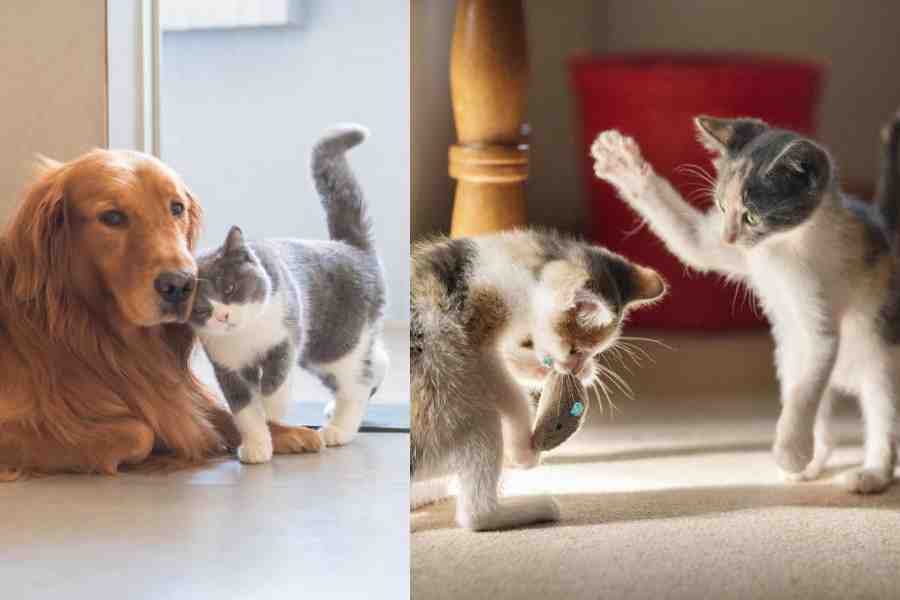Domestic cats have been living alongside humans for an estimated 10,000 years, first as rodent control and then as the couch-warmers we know and love. A far cry from the lone predator lifestyle of their ancestors, today millions of cats worldwide live within human families. While statistics are not available for India, more than 30 per cent of households own a cat in the United States and Australia.
We highly value the relationships we share with these furry companions, frequently considering them friends, family members or even children. This sentiment may be shared, with cats demonstrating affection through seeking out our company, physical contact and engaging in play. Like a secret language between friends, there is even evidence to suggest cats have developed specific vocalisations to communicate with their human parents.
Despite this, cats are typically seen as aloof and elusive. But how true is this? Do cats form friendships beyond us?
Complex recipe
Firstly, what does a cat friendship look like? Behaviours that may indicate friendship between two cats include social grooming, such as licking each other’s fur, head rubbing, spending time together and playing together.
In contrast, behaviour such as charging, fighting or chasing may indicate a disagreement is brewing or already underway.
Cats also have very few conflict-defusing signals in their behavioural repertoire, choosing to run away or avoid each other rather than attempt reconciliation during conflict.
Such disharmony can be stressful for the cats. Many cat parents end up wondering how to maximise the chances of fostering a positive relationship between their cat and other pets – or if they should get them a “friend” at all.

People can be the best friends for cats
The recipe for successful feline friendships is a little complex. Research on cat dynamics in unowned, free-ranging cats has found close relationships are more likely to form — and last – if they are both female, grow up together, are closely related, and live in close proximity to one another.
Indoor-only cats can also form strong friendships with other cats in the household. Similar to unowned free-ranging cats, felines who have been introduced to one another at a young age, who are related, and who have lived together for a long time, are more likely to be close friends.
However, among de-sexed cats, male pairs show closer bonds than male-female pairs. Female pairs are the least likely to be friends. Their first introduction is also the most predictive factor for positive long-term relationships.
Alley cats
We know less about the social lives of pet cats that are allowed to roam outside, but the default behaviour for most cats is one of competitiveness and territorialism. That said, cats will typically try to avoid confrontations with others.
While some research has found that interactions between roaming cats are usually calm, they can and do sometimes result in fights – particularly if food is around or they venture into an unfamiliar unowned cats’ territory.
To complicate things further, two cats are more likely to fight within a household if they are allowed outside — likely due to bringing in unfamiliar scents.
We also can’t forget the problematic relationship cats can have with native fauna, sometimes decimating local wildlife populations. In many places, especially in parts of Australia, cats are not allowed outdoors for this reason. There are also dangers to their own safety if allowed to roam, such as risks from road traffic, and disgruntled neighbours.
While research has mainly explored cats’ friendship with each other, cats can also have positive relationships with other species. For example, while cats and dogs are commonly depicted as mortal enemies, they can live harmoniously, often sleeping and playing together.
However, once again, the importance of early exposure and slow introductions in developing this relationship cannot be overstated. It also appears that indoor cats are friendlier towards their canine companions than cats allowed outdoors, possibly because outdoor cats may be exposed to multiple dogs, many of which aren’t happy to see them.
Cat’s best friend
If you do plan to introduce your cat to a new companion, make sure the introduction is slow and supervised, to increase the chance of a positive first meeting.
Your house should also have plenty of safe spaces, toys and puzzle feeders, scratching posts, and separate food and litter areas in a quiet spot. Providing these resources will help prevent resource guarding (where cats stop other cats from accessing things they need or like) and reduce conflict between the animals.

A puppy and kitten at play
Shanoo Sarkar of New Town’s Shukhobrishti complex has a cat named Motu now, but at one point, had as many as 17 cats living in her house. “It used to be wonderful,” she recalls. “The kittens would go on smacking sprees if their siblings would drink milk from their mother without them. They’d fight, but in jest, without intending to hurt and would unite if any one of them was threatened by an outsider.”
She recounts an incident when an alley cat managed to sneak into their house but was challenged to a duel by one of her own cats. “It was a vicious fight, and when I tried to separate them with a stick, the alley cat dug his nails into my hand. Now I know that the best way to stop cats from fighting is to splash water on them. It does them no harm, and the cats flee the scene immediately as they dislike water.”
Motu was best friends with some other cats in their fold, but now that the others are no more, he is most attached to Shanoo’s husband.
At the end of the day, while cats can form friendships with other animals, they aren’t crucial to their health and happiness. Your cat’s closest relationship is the one it has with you. Ensuring they have lots of opportunities to bask in your attention and engage in play is likely enough for even the most social of felines.
Written with inputs from PTI











